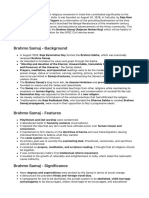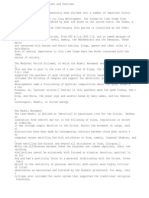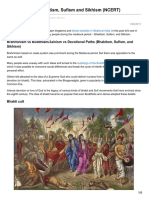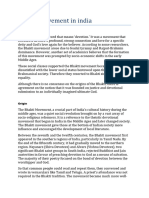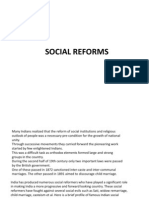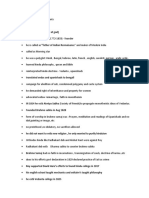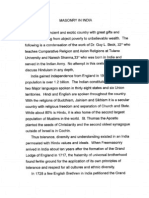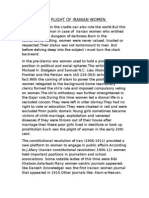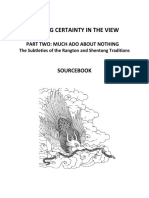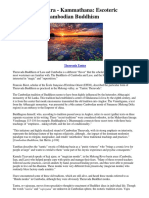Brahma Samaj
Brahma Samaj
Uploaded by
Anusua ChowdhuryCopyright:
Available Formats
Brahma Samaj
Brahma Samaj
Uploaded by
Anusua ChowdhuryOriginal Description:
Copyright
Available Formats
Share this document
Did you find this document useful?
Is this content inappropriate?
Copyright:
Available Formats
Brahma Samaj
Brahma Samaj
Uploaded by
Anusua ChowdhuryCopyright:
Available Formats
The multiple schisms of Brahma Samaj.
The emergence of Brahma Samaj was not automatic, it was occasioned by a concatenation of circumsatances.It inevitabely owed its origin to the eclectic vision of Rammohun Roy.The Brahma Samaj grew out of the subsequent "encounter" between Rammohun Roy and diverse religious faith.The tenets of upanishads and vedanta philosophy and precepts of christianity converged with the doctrine of Braham Samaj. Precisely, the samaj exhibited a melange of orient and occident philosophy, underscoring their main principles and brought it into the purview of functionality.The religious ideas of Rammohun Roy was a composite whole, culminating in the foundation of Brahma samaj in the early 19th cent.Now it is incumbent on me to explain the evolution of Brahma samaj stressing its multiple schisms and eclipses. According to J.N Farquhar, Modern Religious Movements in India, throughout its history Brahma Samaj had been sternly theistic and opposed to religious idolatry,had always had a policy of reform.Farquhar argues, Looked at from one side, it demonstrated an endevour to found a spiritual religion on a genuine hindu foundation; while from the other side, it was a novel creation, entrenched in christian principles.Hem Chandra Sarkar,The Religion of the Brahma Samaj, claims Brahmoism was the religion of future humanity, born of the union between east and west. To its founder, Raja Rammohun Roy concocted the sublime ideal of a Universal religion cutting across the barriers of caste, color, race and nationality. Too greater degree, it assumed the character of international religion without conforming to any specific religious belief. With the inception of the glimmering phase of Brahma Samaj the all-pervasive spiritual longings of Rammohun Roy got an apeture.In 1814 with a definite opinion to devote his whole time and strenght to propagating religious conviction Roy arrived in Calcutta.In 1815 Roy established a society called Atmiya Sabha or Friendly Association which aimed to hold meetings weekly and they recited hymns from various religious scriptures. For 14 years he laboured on his mission, delivering his message to the circle of friends clustered round
him and through written discourses to the wider public. The generality of hindus and christians failed to comprehend him and attacked him vehemently. Rammohun Roy, however, hinged on authoritative scriptures to silence his opponents.H.C Sarkar further argues, Roy braved the assaults of bigoted hindus and orthodox christians to establish the universal religion of "one god,one humanity". On 22nd August,1828 he succeeded in organising a weekly congregation for the worship of god, irrespective of caste and creed. Two years later, in 1830 he erected a modest building for the Theistic Church or Brahma Samaj in the central part of Calcutta.It emerged as a major religious movement of the middle-class educated bengalis,based on the essential principle of monotheism.Everyone came to the samaj and expressed their reverence for god by chanting his praise in their own language.Murdoch noted," the trustee of the building laid down that this building should be used as a place of meeting for the worship of the eternal,unsearchable,immutable being who is the author and the preserver of the universe....". No portrait,graven image, sculpture or stone should be admitted to the samaj, sacrifice at the altar was uncommon, and there was a restriction to the deliverance of sermons.Therefore, elaborate hindu rites and rituals played no loathsome game in the samaj. John Murdoch,The Brahma Samaj and other modern eclectic system of religion in India, argues, It was thus the germ of the first theistic church was planted in Calcutta.It inaugurated a new era in the history of Indian religious thought.It ushered in the dawn of the greatest change that the hindu mind had ever come across.Murdoch claims, It was the introduction of the first public worship and united prayer ---hitherto alien to the hindu religion.Sir Monier Williams, Religious Thought, argues, no other reformation had resulted in the same way from European education and Christian ideas. Meanwhile, Raja Rammohun Roy embarked for England, leaving the fledgling samaj in the care of Ram Chandra Vidyabagish.Roy breathed his last in England, Bristol in September, 1833. In his absence the samaj was retiring into oblivion, as the majority of disciples withdrew their
membership from the samaj. Had not Debendranath Tagore lent support to the samaj,it would have nipped in bud. The elder son of Prince Dwarkanath Tagore, Debendra , after a rigorous meditation discovered a new zeal in the presence of God, that the idols they worshipped were not god, god was perceived by senses. Hem Chandra Sarkar argues, Debendra studied Upanishads uder the aegis of Vidyabagish and founded a society called "Tattwabodhini Sabha" (the society for the propagation of truth) in order to diffuse ancient theistic literature of India.During this time in 1840 the brahma samaj was at its lowest ebb, reduced into relative obscurity.Brian A. Hatcher, "Bourgeois Hinduism, Or the Faith of the Modern Vedantists", deals with Roy as a deceased reformer whose institutional legacy, the brahma samaj was languishing and straying from its founding principles until Tattwabodhini Sabha and Debendranath Tagore, its guiding force revived its memory.The two socities seamlessly coalesced under one umbrella giving a new shape to the ideal of universal religion.Debendra kept the spirit of the Samaj alive and effervescent. His active mind devised many new measures and founded "Tattwabodhini Patrika" as the organ of Brahma Samaj.During his time the samaj drew legion disciples into the vortex of the movement.It was nothing but a motley congregation which listened to hymns from various sanskrit scriptures and religious discourses. It was under Debendra's aegis and inspiration that the Brahma Samaj crystallised into a purely theistic congregation.He drew up a Brahma Covenant,containing a number of vows enjoining the renunciation of idolatry, worship of one and only God, and the practise of virtues.Thus was formed the nucleus of brahmo community, extending the membership of covenated Brahmos to 767 in 1847. The doctrine of Brahma Samaj from the outset was profoundly influenced by the upanishads and vedanta philosophy.The doctrine of the infallibility of Vedanta was accepted by the Samaj.However,Debendra's own faith in Brahmoism was independent of the upanishads or any religious discourses, yet he had a great reverence and prediliction for the hindu
scriptures.The emerging generation even refused to accept the infallibility of the upanishads. A veritable conundrum centering the infallibility of upanishads and vedanta was raised.After a wide discussion with vedic teachers in Benaras, Debendra founded that the doctrine of the infallibility of the upanishads was untenable.H.C Sarkar argues that the early vedic unitarianism was superceded by the natural universal theism in 1848.From 1850 on, Debendra with a view to percolate the message of Brahmoism down the mofussil towns, accumulated a small band of preachers. From the late 19th cent., the complexion of the Brahma Samaj began to change at a rapid pace. The sermons delivered from the pulpit by Debendra created a consternation among the young generation.The joining of Keshub Chandra Sen provided a new momentum to the samaj.Both Kesub and Debendra woked in unison and harmony for a long time. They toured various places across India, particularly Maharashtra and Madras ; under their influence various theistic associations developed,like prarthana Samaj in Bombay in 1867. For a time the progress of the samaj was rapid and extensive and the determination was unflinching.However, a mild chasm sprang up between Debendranath and keshub chandra sen which gradually took a heavy toll on Samaj.H.C Sarkar argues, that the main cause of mis-understanding was in the old ministers of Brahma Samaj who still retained symbols of caste and idolatry i.e, the sacrificial thread worn by this group of ministers. A cohort of young people clustered round Keshub Sen strictly opposed the observation of hindu rites and rituals.However, Debendra was reluctant to deal with the old ministers of the samaj carrying sacred thread as an emblem of their faith.Thus grew up two factions, progressive and conservative within the Samaj. At first Debendra yielded, but later on, the old ministers were allowed to officiate. About this time the progressive part solemnized an inter-caste marriage in the Brahma samaj.Being flown into rage, Debendra re-instated the old minsiters consulting the progressive party.This in consequence had widened the abyss between the two wings of the Samaj.Terrified Debendra withdrew all the
young members along with Keshub from the Samaj. Failing in their attempt to preserve their identity within the Adi Samaj, the progressive party crystallized into the Brahma Samaj of India in 1866. A bulk of young men joined the spirit of the Samaj, providing a momentum to it. In 1870 Keshub Chandra Sen along with his friends and disciples paid a visit to England, there they were received with utmost honour and cordiality. Internally, the Brahma Samaj of India observed many radical developments and changes.The samaj made new direction towards catholicity under Keshub Sen, and at this time he read a great deal of christian literature; Dean Stanley's works,Robertson's Sermons,Liddon's Divinity of our lord. Under Debendra the avenues of the Samaj was confined into hinduism and its influenes.This marked a radical disjuncture with the developments of Adi Samaj.Keshub gave a more universal character to the Samaj,compiling a book based on various religious scriptures, holding a weekly congregation marked by devotional fervor. Moreover, The Act of iii of 1872 legitimized the Brahma marriage and fixed the age of consummation for girls at 14. Pandit Shivnath Sastri remarks: "The passing of this act may be justly regarded as the crowning success of the prolonged efforts of the reformers for the amelioration of the social life...." The new Braham Samaj of India engaged with the orgy of social reforms, particularly emancipation of women.At this juncture, a fateful event spawned a further tension within the Samaj. In 1878 the samajities taken aback when the brilliant Keshub gave his child daughter into marriage with the young Maharaja of Coochbehar.H.C Sarkar claims that the bridegroom was not brahmo and the rumor was, the marriage was solemnized in a stern hindu way.Farquhar observed, Keshub did not agree to this marriage but he succumbed to the pressure of circumstances.However, the Brahma Marriage act was untenable in the native region of Koochbehar but promises were made to abstain from idolatrous rites.At the close quater, the plan miscarried and the marriage was celebrated with hindu rituals.This had further exacerbated tensions within the samaj. The enraged protesters planned to censor Keshub at a meeting of the samaj, but he foiled their
attempts and forcibly held his position as a minister of the Samaj. The radical elements of the Samaj severed all ties with Keshub and his Samaj, and they in turn organised Sadharan Brahma Samaj along the lines of constitutional activities. The Sadharan Samaj was formally inaugurated at a public meeting held in Calcutta in Town Hall, in May 1878.Majority of mofussil samajes were inextricabely allied with the main body.The members were chosen by voting and the mofussil samajes were allowed to send their representatives to the main body in Calcutta. Keshub Sen along with his loyalist's co-operation embarked on a mission across India.He started to make new arrangements for the samaj and in 1880 changed the name of his church into "New Dispensation",twelve missionaries were came to be regarded as the "Apostles " of the church.However, the new dispensation encountered serious crises eclipsing the organization. The death of babu Keshub baffled everyone associated with the new dispensation.The zeal subsequently died out and the apostles were gravely disorganised operating in isolated pockets. Hence we can deduce, the Brahma Samaj initiated by Rammohun Roy involved an assembly of people of all hues of theistic belief.After its main proponent passed away, the activity of the Samaj fell within the province of Debendranath Tagore.The activities of the Samaj prospered and alliance with Keshub was much credited. But soon the samaj was overwhelmed by recurrent disputes resulting into manifold catastrophes. It was characterized by mulitiple fissures and lacuna eating into the vitals of the society.No leader or reformer in actual sense could maintain the elasticity of the Brahma Samaj or refurbish the samaj. Moreover, the radical constituents generated huge factionalism accentuating tensions within the Samaj. Thus, the main essence of the Samaj disappeared culminating into segregated societies under the same rubric of Brahma Samaj.
You might also like
- Conversation of Shiva ShaktiDocument4 pagesConversation of Shiva ShaktisrimatsimhasaneshwarNo ratings yet
- The Isha Upanishad Translated by Eknath EaswaranDocument2 pagesThe Isha Upanishad Translated by Eknath EaswaranBen Jessica RNo ratings yet
- Prayer For Local National Elections by Derek Prince MinistriesDocument1 pagePrayer For Local National Elections by Derek Prince MinistriesEdmond BlairNo ratings yet
- Brahmo Samaj Presentation MRSMIDocument5 pagesBrahmo Samaj Presentation MRSMIGospel VanlalrinchhanaNo ratings yet
- Adobe Scan 03 Jan 2022 PDFDocument5 pagesAdobe Scan 03 Jan 2022 PDFShivangi BoseNo ratings yet
- Socio Religious Reform MovementsDocument14 pagesSocio Religious Reform Movementssumedha bhowmickNo ratings yet
- Share 021806Document7 pagesShare 021806S B THANGLAMPAUA 6213No ratings yet
- Brahmo SamajDocument4 pagesBrahmo SamajShruti BhartiNo ratings yet
- 14-History of Brahmo Samaj PDFDocument16 pages14-History of Brahmo Samaj PDFSubrata Biswas100% (2)
- Brahmo SamajDocument3 pagesBrahmo SamajYoshi XinghNo ratings yet
- Bhakti MovementDocument10 pagesBhakti MovementHivi100% (1)
- Midterm Exam 2 Question #2 HIST475Y, Chatterjee Shannon RatliffDocument12 pagesMidterm Exam 2 Question #2 HIST475Y, Chatterjee Shannon RatliffsmratliffNo ratings yet
- Assignment Socio - Religious Reform Movements: History of India - 6 (C. 1750 - 1857)Document9 pagesAssignment Socio - Religious Reform Movements: History of India - 6 (C. 1750 - 1857)Anakha LaijuNo ratings yet
- Hist Last ClassDocument3 pagesHist Last ClassAsmitNo ratings yet
- Bhakti Movement in IndiaDocument4 pagesBhakti Movement in Indiachukogrande100% (1)
- Social and Religious Reform MovementsDocument6 pagesSocial and Religious Reform MovementsUNKNOWN CONTACTNo ratings yet
- SOCIO-RELIGIOUS REFORM MOVEMENTS of 19th CENTURYDocument27 pagesSOCIO-RELIGIOUS REFORM MOVEMENTS of 19th CENTURYSudhanshu TiwariNo ratings yet
- Ans Socio-Religious MovementsDocument4 pagesAns Socio-Religious MovementsShivangi Kumari -Connecting Fashion With HistoryNo ratings yet
- History of Brahmo SamajDocument2 pagesHistory of Brahmo SamajchaitanyaNo ratings yet
- Reforms: I. The Brahmo Samaj (The Society of God)Document7 pagesReforms: I. The Brahmo Samaj (The Society of God)Anushree MahindraNo ratings yet
- Social Movements Are A Type of Group ActionDocument26 pagesSocial Movements Are A Type of Group ActionSharath_CNo ratings yet
- Brahma Samaj and Arya SamajDocument3 pagesBrahma Samaj and Arya SamajRakrik SangmaNo ratings yet
- Bhakthi Movement and NamasankeerthanamDocument22 pagesBhakthi Movement and NamasankeerthanamT Sampath Kumaran100% (2)
- Bhakti MovementDocument4 pagesBhakti MovementRamita Udayashankar100% (5)
- NCH L-24 (Courtesy by Kaisar) - Suraiya IslamDocument4 pagesNCH L-24 (Courtesy by Kaisar) - Suraiya IslamMd. Kaisar SyedNo ratings yet
- Class 16 - Bengal Renaissance and Raja Rammuhan Roy - Nov 29 2022Document33 pagesClass 16 - Bengal Renaissance and Raja Rammuhan Roy - Nov 29 2022Afrin AnwarNo ratings yet
- Social Reforms PDFDocument30 pagesSocial Reforms PDFAshokNo ratings yet
- Social ReformersDocument15 pagesSocial ReformersShanmuka NalliNo ratings yet
- Keshab Chandra SenDocument7 pagesKeshab Chandra SenAnusuya BaruahNo ratings yet
- NCH L-24 (Courtesy by Kaisar Syed) - Suraiya IslamDocument4 pagesNCH L-24 (Courtesy by Kaisar Syed) - Suraiya IslamMd. Kaisar SyedNo ratings yet
- Bhakti Movement in IndiaDocument18 pagesBhakti Movement in IndiaM TejaNo ratings yet
- Socio-Religio Reforms of British in IndiaDocument7 pagesSocio-Religio Reforms of British in IndiaMahamIsmailNo ratings yet
- Brohmo SamajDocument27 pagesBrohmo SamajMyuli AwngNo ratings yet
- History of India AssignmentDocument5 pagesHistory of India AssignmentUjjwal YadavNo ratings yet
- Aspects of Bhakti Movement in India: TH THDocument10 pagesAspects of Bhakti Movement in India: TH THchaudhurisNo ratings yet
- Bhakti MovementDocument17 pagesBhakti Movementcedric241986No ratings yet
- Medieval India Bhaktism Sufism and Sikhism NCERTDocument8 pagesMedieval India Bhaktism Sufism and Sikhism NCERTsagarthegameNo ratings yet
- Medieval History Department ECC (Unofficial) - Reforms of BrahmoDocument9 pagesMedieval History Department ECC (Unofficial) - Reforms of BrahmoYuva SinghNo ratings yet
- Social ReformersDocument10 pagesSocial Reformersvenka07No ratings yet
- The Growth of SufismDocument14 pagesThe Growth of Sufismbabitagosain16No ratings yet
- SPREAD OF THE MOVEMENT AND CONSTRAINTS HistoryDocument2 pagesSPREAD OF THE MOVEMENT AND CONSTRAINTS Historyaryan jainNo ratings yet
- Socio ReformersDocument13 pagesSocio ReformersDr-Payal BaseraNo ratings yet
- Brahmo Samaj and Raja Ram Mohan RoyDocument15 pagesBrahmo Samaj and Raja Ram Mohan RoyPrince PrasanthNo ratings yet
- Jainism and Buddhism Causes For The Rise of Jainism and BuddhismDocument11 pagesJainism and Buddhism Causes For The Rise of Jainism and BuddhismShivangi BajpaiNo ratings yet
- CC7 Mod4bDocument6 pagesCC7 Mod4bkaushal yadavNo ratings yet
- Social and Religious MovementsDocument5 pagesSocial and Religious Movementsjyuvi360No ratings yet
- 32tagore's ReligionDocument8 pages32tagore's ReligionMaung Maung ThanNo ratings yet
- Brahmo SamajDocument18 pagesBrahmo SamajSyed Farhan AliNo ratings yet
- Unit-3 (D) The Sufi Bhakti Movements Importance of These MovementsDocument34 pagesUnit-3 (D) The Sufi Bhakti Movements Importance of These Movementsjagmohan.jk11No ratings yet
- Hist7 - 8 - Devotional Paths To The Divine PDFDocument18 pagesHist7 - 8 - Devotional Paths To The Divine PDFRavi GarcharNo ratings yet
- Raja Ram Mohan RoyDocument4 pagesRaja Ram Mohan RoyPriyankaNo ratings yet
- Bhakti Movement & Sufi MovementDocument4 pagesBhakti Movement & Sufi Movementimteyazali4001No ratings yet
- General Survey of Social ReformersDocument14 pagesGeneral Survey of Social ReformersVrushali ThokalNo ratings yet
- Sufi and Bhakti Movement PDFDocument4 pagesSufi and Bhakti Movement PDFAkshara KamathNo ratings yet
- Prarthana SamajDocument2 pagesPrarthana SamajxadarshjhaNo ratings yet
- Bakthi and Sufi MovementDocument32 pagesBakthi and Sufi MovementVivek AnandhanNo ratings yet
- Indian Renaissance 1 - 32972070 - 2024 - 08 - 07 - 16 - 25Document10 pagesIndian Renaissance 1 - 32972070 - 2024 - 08 - 07 - 16 - 25demidevil16No ratings yet
- Buddhism: Cristian ViolattiDocument12 pagesBuddhism: Cristian ViolattiJEEHAN DELA CRUZNo ratings yet
- Masonry in IndiaDocument7 pagesMasonry in IndiaGhazanfar Abbas100% (1)
- 978 1 4438 2490 3 SampleDocument30 pages978 1 4438 2490 3 SamplePradeep MishraNo ratings yet
- Plight of Iranian WomenDocument5 pagesPlight of Iranian WomenAnusua ChowdhuryNo ratings yet
- Bengal RenaissanceDocument9 pagesBengal RenaissanceAnusua ChowdhuryNo ratings yet
- Brenner ThesisDocument10 pagesBrenner ThesisAnusua ChowdhuryNo ratings yet
- ZaibatsuDocument5 pagesZaibatsuAnusua ChowdhuryNo ratings yet
- Paladin of Western EducationDocument5 pagesPaladin of Western EducationAnusua ChowdhuryNo ratings yet
- Chogay Trichen Rinpoche - The History of The Sakya TraditionDocument78 pagesChogay Trichen Rinpoche - The History of The Sakya TraditionCornissa Althaqua100% (4)
- Gaining Certainty in The View Two SB v1b PDFDocument195 pagesGaining Certainty in The View Two SB v1b PDFGeroNimo100% (1)
- Solid Gold - Guru TattvaDocument52 pagesSolid Gold - Guru TattvaSri Vanara SenaNo ratings yet
- Theravada Tantra in CambodiaDocument4 pagesTheravada Tantra in CambodiaponphNo ratings yet
- Session 9 Saved in Cell or ChurchDocument11 pagesSession 9 Saved in Cell or ChurchFrancisco NiegasNo ratings yet
- The New Treasure of Dudjom Ngondro The Condensed Meaningful Guide (With Additions From The Long Ngodro)Document15 pagesThe New Treasure of Dudjom Ngondro The Condensed Meaningful Guide (With Additions From The Long Ngodro)Douglas BrodleyNo ratings yet
- Religion and SpiritualityDocument7 pagesReligion and SpiritualitySwami Gurunand100% (1)
- VamacharaDocument4 pagesVamacharaMortalNo ratings yet
- RootlightShield of Defense MeditationsDocument2 pagesRootlightShield of Defense MeditationsJavier De Aramburú PalermoNo ratings yet
- Unit-Outline-1 UpdatedDocument22 pagesUnit-Outline-1 Updatedapi-357570712No ratings yet
- A Source of Social ActionDocument41 pagesA Source of Social ActionTwinkle Star CallaNo ratings yet
- The Tibetan Book of The Great Liberation Padma Sambhava PDFDocument104 pagesThe Tibetan Book of The Great Liberation Padma Sambhava PDFjotapedroNo ratings yet
- The Celestine Prophecy, James RedfieldDocument3 pagesThe Celestine Prophecy, James RedfieldSergio CuberoNo ratings yet
- Introduction of Madhusūdana Sarasvatī's Gū Ārtha Dīpikā, A Unique Commentary On Bhagavad GītāDocument7 pagesIntroduction of Madhusūdana Sarasvatī's Gū Ārtha Dīpikā, A Unique Commentary On Bhagavad GītāIndiaspirituality AmrutNo ratings yet
- Hamsa PriyaDocument12 pagesHamsa Priyavpshri2299No ratings yet
- Ngondro, The Preliminary PracticesDocument4 pagesNgondro, The Preliminary PracticesTomNo ratings yet
- Godly Play Anointing of The SickDocument4 pagesGodly Play Anointing of The Sickapi-294340867No ratings yet
- Swami Vivekananda B.edDocument11 pagesSwami Vivekananda B.edSHEFALI SINGHNo ratings yet
- The Principle Teachings of Buddhism, Level 1 of The Steps To Buddhahood (Lam Rim)Document355 pagesThe Principle Teachings of Buddhism, Level 1 of The Steps To Buddhahood (Lam Rim)Sierra ShaferNo ratings yet
- A Comparative AnalysisDocument2 pagesA Comparative AnalysisKomsaara100% (1)
- 1 Gaona BrianDocument218 pages1 Gaona BrianElias Nicol100% (1)
- Zong Rinpoche 2013Document15 pagesZong Rinpoche 2013Uyen Doan0% (1)
- Shaheed Sukhdev College of Business Studies Delhi UniversityDocument46 pagesShaheed Sukhdev College of Business Studies Delhi UniversitySrijan Saxena100% (14)
- Impact of Spiritual LeadershipDocument12 pagesImpact of Spiritual Leadershiphasan aliNo ratings yet
- Meditation On OmDocument124 pagesMeditation On Omkartikscribd100% (16)
- AGATHIYAR திக்ஷா விதிDocument10 pagesAGATHIYAR திக்ஷா விதிkarthikkumaranee100% (1)
- Hatha YogaDocument2 pagesHatha YogaAishra A ShettyNo ratings yet









